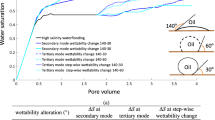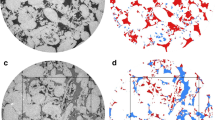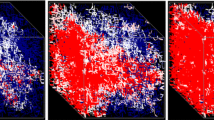Abstract
Wettability is an important factor affecting fluid behavior in the subsurface, including oil, gas, and supercritical \(\hbox {CO}_2\) in deep geological reservoirs. For example, \(\hbox {CO}_2\) is generally assumed to behave as a non-wetting fluid, which favors safe storage. However, because of chemical heterogeneity of the reservoirs, mixed wettability conditions can exist. Furthermore, recent experiments suggest that with time, the wettability of super-critical \(\hbox {CO}_2\) may change from non-wetting to partially wetting due to changes in electrostatic interactions. These changes are caused by chemical reactions between dissolved \(\hbox {CO}_2\) and its environment. To date, the effect of wettability alteration and mixed wettability on the long-term fate of injected \(\hbox {CO}_2\) has not well been studied. Here, we use the multiphase pairwise force smoothed particle hydrodynamics model to study complex pore-scale processes involved in geological \(\hbox {CO}_2\) sequestration, including the effect of spatial and temporal wettability variations on long-term distribution of \(\hbox {CO}_2\) in porous media. Results reveal that in the absence of dissolution of supercritical \(\hbox {CO}_2\) and precipitation of carbonate minerals (mineral trapping), the amount of trapped supercritical \(\hbox {CO}_2\) significantly decreases as the wettability of the porous media changes from brine-wet to partial-wet or \(\hbox {CO}_2\)-wet.








Similar content being viewed by others
References
Metz B, Davidson O, de Coninck H, Loos M, Meyer L (2005) IPCC special report on carbon dioxide capture and storage, Technical Report DOE/BC/93000174 (Prepared by Working Group III of the Intergovernmental Panel on Climate Change University of California, Berkeley)
Anderson WG (1986) Wettability literature survey- part 1: rock/oil/brine interactions and the effects of core handling on wettability. J Petrol Technol 38:1125
Chiquet P, Broseta D, Thibeau S (2007) Wettability alteration of caprock minerals by carbon dioxide. Geofluids 7:112
Chalbaud C, Robin M, Lombard J-M, Martin F, Egermann P, Bertin H (2009a) Wettability impact on \(\text{ CO }_2\) storage in aquifers: visualization and quantification using micromodel tests, pore network model and reservoir simulations. Int Symp Soc Core Anal 32:98
Chalbaud C, Robin M, Lombard J-M, Martin F, Egermann P, Bertin H (2009b) Interfacial tension measurements and wettability evaluation for geological \(\text{ CO }_2\) storage. Adv Water Resour 32:98
Domnguez A, Prez-Aguilar H, Rojas F, Kornhauser I (2001) Mixed wettability: a numerical study of the consequences of porous media morphology. Colloids Surf A 415:187–188
Morrow NR, Lim HT, Ward JS (1986) Effect of crude-oil-induced wettability changes on oil recovery. SPE Form Eval 1:89
Buckley JS, Liu Y (1998) Some mechanisms of crude oil/brine/solid interactions. J Petrol Sci Eng 20:155
Buckley J, Liu Y, Monsterleet S (1998) Mechanisms of wetting alteration by crude oils. SPE J 3:54
Spiteri E, Juanes R, Blunt M, F O Jr (2008) A new model of trapping and relative permeability hysteresis for all wettability characteristics. SPE J 13:277
Chalbaud C, Robin M, Lombard J-M, Bertin H, Egermann P (2010) Brine/\(\text{ CO }_2\) interfacial properties and effects on \(\text{ CO }_2\) storage in deep saline aquifers. Oil Gas Sci Technol Rev IFP 65:541
Gaus I (2010) Role and impact of co2-rock interactions during \(\text{ CO }_2\) storage in sedimentary rocks. Int J Greenh Gas Control 4:73
Kim Y, Wan J, Kneafsey TJ, Tokunaga TK (2012) Dewetting of silica surfaces upon reactions with supercritical \(\text{ CO }_2\) and brine: Pore-scale studies in micromodels. Environ Sci Technol 46:4228–4235
Shao H, Ray JR, Jun Y-S (2010) Dissolution and precipitation of clay minerals under geologic \(\text{ CO }_{2}\) sequestration conditions: \(\text{ CO }_{2}\) brinephlogopite interactions. Environ Sci Technol 44:5999
Israelachvili JN (2010) Intermolecular and surface forces, 3rd edn. Academic Press, New York
Xu T, Apps JA, Pruess K (2003) Reactive geochemical transport simulation to study mineral trapping for \(\text{ CO }_{2}\) disposal in deep arenaceous formations. J Geophys Res 108(2). doi:10.1029/2002JB001979
Downs HH, Hoover PD (1989) Enhanced oil recovery by wettability alteration. In: Borchardt JK (ed) Oil-field chemistry, Chap 33. American Chemical Society, Washington, DC, pp 577–595
Jadhunandan P, Morrow N (1995) Effect of wettability on water ood recovery for crude-oil/brine/rock systems. SPE Reserv Eng 10:40
Blunt MJ (1997) Pore level modeling of the effects of wettability. SPE J 2:494
Zhang P, Austad T (2006) Wettability and oil recovery from carbonates: effects of temperature and potential determining ions. Colloids Surf A 279:179
Zhao X, Blunt MJ, Yao J (2010) Pore-scale modeling: effects of wettability on waterflood oil recovery. J Petrol Sci Eng 71:169 fourth international symposium on hydrocarbons and chemistry
Tartakovsky AM, Meakin P (2006) Pore scale modeling of immiscible and miscible fluid flows using smoothed particle hydrodynamics. Adv Water Resour 29:1464
Palmer B, Gurumoorthi V, Tartakovsky A, Scheibe T (2010) A component-based framework for smoothed particle hydrodynamics simulations of reactive fluid flow in porous media. Int J High Perform Comput Appl 24:228
Dussan EV (1979) On the spreading of liquids on solid surfaces: static and dynamic contact lines. Ann Rev Fluid Dyn 11:371
Huh C, Scriven L (1971) Hydrodynamic model of steady movement of a solid/liquid/fluid contact line. J Colloid Interface Sci 35:85
Tanner LH (1979) The spreading of silicone oil drops on horizontal surfaces. J Phys D 12:1473
de Gennes P (1985) Wetting: statics and dynamics. Rev Modern Phys 57:827
Nijmeijer M, Nijmeijer MJP, Bruin C, Bakker AF, van Leeuwen JMJ (1990) Wetting and drying of an inert wall by a fluid in a molecular-dynamics simulation. Phys Rev A 42:6052
Monaghan JJ (2005) Smoothed particle hydrodynamics. Rep Prog Phys 68:1703
Tartakovsky A, Meakin P (2005) Modeling of surface tension and contact angles with smoothed particle hydrodynamics. Phys Rev E 72:026301
Tartakovsky AM, Meakin P (2005) Simulation of free-surface flow and injection of fluids into fracture apertures using smoothed particle hydrodynamics. Vadose Zone J 4:848
Tartakovsky A, Meakin P, Ward A (2009) Smoothed particle hydrodynamics model of non-aqueous phase liquid flow and dissolution. Transp Porous Media 76:11
Tartakovsky AM, Ward AL, Meakin P (2007) Pore-scale simulations of drainage of heterogeneous and anisotropic porous media. Phys Fluids 19:103301
Bandara U, Tartakovsky A, Oostrom M, Palmer B, Grate J, Zhang C (2013) Smoothed particle hydrodynamics pore- scale simulations of unstable immiscible flow in porous media. Advances inWater Resour 62, Part C:356
Kordilla J, Tartakovsky A, Geyer T (2013) A smoothed particle hydrodynamics model for droplet and film flow on smooth and rough fracture surfaces. Adv Water Resour 59:1
Morris JP, Fox PJ, Zhu Y (1997) Modeling low reynolds number incompressible flows using SPH. J Comput Phys 136:214
Holmes DW, Williams JR, Tilke P (2011) Smooth particle hydrodynamics simulations of low reynolds number flows through porous media. Int J Numer Anal Methods Geomech 35:419
Pereira G, Prakash M, Cleary P (2011) \(\{\text{ SPH }\}\) modelling of fluid at the grain level in a porous medium. Appl Math Modell 35:1666
Tartakovsky A, Scheibe T (2011) Dimension reduction numerical closure method for advection-diffusion-reaction systems. Adv Water Resour 34:1616
Tartakovsky AM, Meakin P, Scheibe T, Wood B (2007) A smoothed particle hydrodynamics model for reactive transport and mineral precipitation in porous and fractured porous media. Water Resour Res 43:W05437
Tartakovsky AM, Meakin P, Scheibe TD, Eichler West RM (2007) Simulations of reactive transport and precipitation with smoothed particle hydrodynamics. J Comput Phys 222:654
Ryan EM, Tartakovsky AM (2011) A hybrid micro-scale model for transport in connected macro-pores in porous media. J Contaminant Hydrol 126:61
Ryan EM, Tartakovsky AM, Amon C (2011) Pore-scale modeling of competitive adsorption in porous media. J Contaminant Hydrol 120–121:56
de Anna P, Borgne TL, Dentz M, Tartakovsky AM, Bolster D, Davy P (2013) Flow intermittency, dispersion, and correlated continuous time random walks in porous media. Phys Rev Lett 110:184502
Barker DJ, Neethling SJ, Parameswaran G (2012) Isph simulation of packed-beds and columns applied to heap—leaching. CSIRO, Melbourne
Meakin P, Tartakovsky AM (2009) Modeling and simulation of pore-scale multiphase fluid flow and reactive transport in fractured and porous media. Rev Geophys 47:n/a
Tartakovsky A, Trask N, Pan K, Jones B, Pan W, Williams J (2015) Smoothed particle hydrodynamics and its applications for multiphase flow and reactive transport in porous media. Comput Geosci 1–28
Bonn D, Eggers J, Indekeu J, Meunier J, Rolley E (2009) Wetting and spreading. Rev Mod Phys 81:739
Tartakovsky AM, Panchenko A (2015) Pairwise force smoothed particle hydrodynamics model for multiphase flow: surface tension and contact line dynamics. J Comput Phys. doi:10.1016/j.jcp.2015.08.037 (in press)
Allen MP, Tildesley DJ (1989) Computer simulation of liquids. Oxford University Press, Oxford
Lenormand R, Touboul E, Zarcone C (1988) Numerical models and experiments on immiscible displacements in porous media. J Fluid Mech (UK) 189:165
Andre L, Audigane P, Azaroual M, Menjoz A (2007) Numerical modeling of fluid-rock chemical interactions at the supercritical \(\text{ CO }_{2}\)-liquid interface during \(\text{ CO }_{2}\) injection into a carbonate reservoir, the dogger aquifer (paris basin, france). Energy Convers Manag 48:1782
Bielinski A (1993) Numerical simulation of \(\text{ CO }_{2}\) sequestration in geological formations, Technical Report DOE/BC/93000174 University of California, Berkeley
Ewing PR, Berkowitz B (1998) A generalized growth model for simulating initial migration of dense non-aqueous phase liquids. Water Resour Res 34:611
Held RJ, Illangasekare TH (1995) Fingering of dense nonaqueous phase liquids in porous media 1. experimental investigation. Water Resour Res 31:1213
Lenormand R, Zarcone C, Sarr A (1983) Mechanisms of the displacement of one fluid by another in a network of capillary ducts. J Fluid Mech 135:337
Blunt M, Scher H (1995) Pore-level modeling of wetting. Phys Rev E 52:6387
Kovscek AR, Radke CJ (1993) Fundamentals of foam transport in porous media. Technical Report DOE/BC/93000174 University of California, Berkeley
Acknowledgments
A.M. Tartakovsky gratefully acknowledges the funding support from the Applied Mathematics Program within the U.S. Department of Energy’s (DOE) Office of Advanced Scientific Computing Research (ASCR) as part of the Early Career Award, “New Dimension Reduction Methods and Scalable Algorithms for Multiscale Non-linear Phenomena.” Pacific Northwest National Laboratory is operated by Battelle for the DOE under Contract DE-AC05-76RL01830.
Author information
Authors and Affiliations
Corresponding author
Rights and permissions
About this article
Cite this article
Bandara, U.C., Palmer, B.J. & Tartakovsky, A.M. Effect of wettability alteration on long-term behavior of fluids in subsurface. Comp. Part. Mech. 3, 277–289 (2016). https://doi.org/10.1007/s40571-015-0098-8
Received:
Revised:
Accepted:
Published:
Issue Date:
DOI: https://doi.org/10.1007/s40571-015-0098-8




